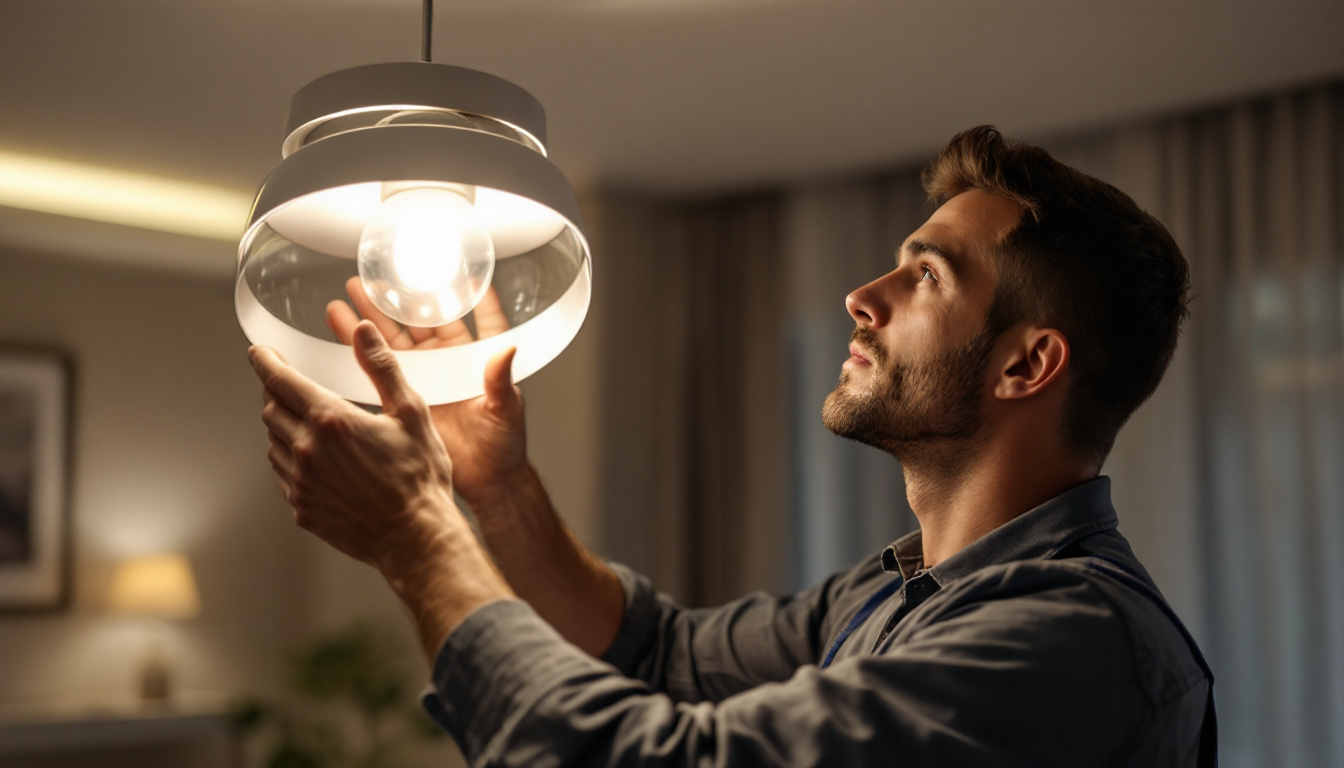
As the demand for innovative lighting solutions continues to rise, understanding the intricacies of ceiling lamp fixtures becomes increasingly important for lighting contractors. This article offers essential tips and insights that can enhance the expertise and efficiency of professionals in this field.
Ceiling lamp fixtures are not merely functional; they serve as a focal point in a room, influencing both aesthetics and ambiance. Familiarity with different types of fixtures is crucial for lighting contractors, as it allows for tailored solutions that meet client needs.
There are various styles of ceiling lamp fixtures, including flush mounts, semi-flush mounts, chandeliers, and pendant lights. Each type has its own unique features and installation requirements, making it imperative for contractors to have a comprehensive understanding of these options.
flush mount fixtures are typically installed directly against the ceiling, making them ideal for rooms with low ceilings. They provide a clean, unobtrusive look while delivering adequate lighting. Semi-flush mounts hang slightly below the ceiling, offering a balance between style and functionality.
Chandeliers, on the other hand, are often used as statement pieces in dining rooms or entryways. They come in various designs, from traditional to modern, and can significantly enhance the overall decor of a space. Pendant lights, which hang from the ceiling by a cord or chain, are versatile and can be used in clusters or alone to create a unique lighting arrangement. The choice of material also plays a crucial role; glass, metal, and even wood can be used to create different moods and styles, allowing homeowners to express their personal taste.
When installing ceiling lamp fixtures, several factors must be taken into account. First, the height of the ceiling plays a critical role in determining the type of fixture that will work best. For instance, in rooms with high ceilings, longer pendant lights or chandeliers may be appropriate, while flush mounts are better suited for lower ceilings.
Additionally, the size of the room should influence the choice of fixture. A large chandelier in a small room can overwhelm the space, while a small flush mount may not provide sufficient light in a larger area. Proper scale and proportion are essential for achieving a harmonious look. Furthermore, the color temperature of the bulbs used in these fixtures can dramatically affect the atmosphere; warm white bulbs create a cozy ambiance, while cool white bulbs can enhance focus and productivity, making them ideal for workspaces or kitchens.
Another important consideration is the fixture’s energy efficiency. With the rise of LED technology, many ceiling lamp fixtures now come with energy-saving options that not only reduce electricity bills but also have a longer lifespan compared to traditional incandescent bulbs. This shift towards energy-efficient lighting solutions is not only beneficial for homeowners but also aligns with broader environmental goals, making it a significant point of discussion among lighting contractors and their clients.
Electrical knowledge is paramount for lighting contractors, particularly when dealing with ceiling lamp fixtures. Ensuring the safety and functionality of the installation requires a thorough understanding of electrical systems and codes. This expertise not only helps in executing the installation correctly but also plays a crucial role in troubleshooting any issues that may arise in the future. A well-informed contractor can anticipate potential problems and address them proactively, thereby enhancing the overall reliability of the lighting installation.
Before installation, it is critical to assess the existing electrical wiring and ensure it can support the new fixture. This includes checking the wattage and voltage requirements of the lamp to avoid potential hazards. Additionally, contractors should be familiar with local electrical codes to ensure compliance and safety. Understanding these codes can also aid in obtaining necessary permits and passing inspections, which are vital steps in any professional installation process. Moreover, staying updated on any changes in regulations can prevent costly mistakes and ensure that the installation meets the latest safety standards.
Proper wiring is essential for the safe operation of ceiling lamp fixtures. Contractors should always turn off the power at the circuit breaker before starting any installation. Using a voltage tester can help confirm that the power is off, preventing any accidents during the process. In addition to these precautions, wearing appropriate personal protective equipment, such as insulated gloves and safety goggles, can further minimize the risk of injury. It’s also advisable to have a first aid kit on hand, just in case an unforeseen incident occurs during the installation.
When connecting wires, it is important to follow color codes: typically, black or red wires are hot, white wires are neutral, and green or bare wires are ground. Secure connections using wire nuts and ensure that all wires are properly insulated to prevent short circuits. Furthermore, it’s beneficial to label wires during the installation process, especially in complex setups. This practice not only aids in future maintenance but also provides clarity for anyone who may work on the electrical system later. Proper documentation of the installation process can also serve as a valuable reference for both contractors and homeowners.
The choice of light bulbs can significantly impact the performance and efficiency of ceiling lamp fixtures. LED bulbs are becoming increasingly popular due to their energy efficiency and longevity. They produce less heat compared to incandescent bulbs, making them a safer option for enclosed fixtures. Additionally, many LED options come with adjustable brightness and color settings, allowing homeowners to customize their lighting experience according to their needs and preferences. This versatility can enhance the functionality of a space, whether it’s for relaxing in the living room or focusing on tasks in a home office.
Contractors should also consider the color temperature of the bulbs, which can affect the mood of a space. Warm white bulbs (around 2700K) create a cozy atmosphere, while cooler bulbs (above 4000K) are better suited for task lighting in workspaces. Beyond color temperature, the lumens output is another critical factor; it determines the brightness of the light. Contractors should educate their clients on the importance of selecting the right lumens for different areas of their home, ensuring that each room is adequately illuminated for its intended use. Furthermore, discussing the environmental impact of different bulb types can help clients make informed choices that align with their sustainability goals.
Beyond functionality, the design of ceiling lamp fixtures plays a vital role in enhancing a space’s aesthetic appeal. Lighting contractors should be well-versed in current design trends and how they can be integrated into their projects.
When selecting fixtures, it is essential to consider the overall style of the room. For instance, a modern minimalist space may benefit from sleek, geometric fixtures, while a traditional setting may call for ornate chandeliers or vintage-inspired designs.
The color and finish of ceiling lamp fixtures can also influence the overall look of a room. Metallic finishes, such as brass or chrome, can add a touch of elegance, while matte black or white fixtures can create a more contemporary feel. Contractors should offer clients a range of options to ensure the chosen fixture complements the existing decor.
Additionally, consider the impact of the fixture’s color on the light it emits. Darker finishes may absorb more light, while lighter colors can reflect it, enhancing brightness in a space.
Effective lighting design often involves layering different types of lighting. Ceiling lamp fixtures can serve as the primary source of ambient light, but contractors should also encourage clients to incorporate task and accent lighting for a well-rounded approach.
For example, combining ceiling fixtures with floor lamps, wall sconces, or under-cabinet lighting can create a dynamic and versatile lighting scheme. This not only enhances functionality but also adds depth and dimension to the space.
Regular maintenance of ceiling lamp fixtures is essential for ensuring their longevity and performance. Contractors should educate clients on proper care and maintenance practices to keep their lighting in optimal condition.
Dust and dirt can accumulate on fixtures over time, affecting their brightness and appearance. Regular cleaning with a soft cloth and appropriate cleaning solutions can help maintain their shine. Additionally, contractors should remind clients to check bulbs periodically and replace any that have burned out to ensure consistent lighting.
Despite best efforts, issues may arise with ceiling lamp fixtures. Flickering lights can indicate a loose connection or an issue with the bulb itself. Contractors should advise clients on how to troubleshoot these problems, such as checking connections and replacing bulbs.
In cases of complete fixture failure, it may be necessary to inspect the wiring and connections more thoroughly. Educating clients on these common issues can empower them to address minor problems without needing immediate professional assistance.
A successful lighting contractor understands the importance of effective client consultation. Taking the time to understand a client’s vision, preferences, and needs can lead to more satisfactory outcomes and stronger client relationships.
During consultations, contractors should ask open-ended questions to gauge the client’s style preferences and functional requirements. This can include discussing the purpose of the space, desired ambiance, and any specific features they want in a ceiling lamp fixture.
After gathering information, contractors should present a range of options that align with the client’s vision. Providing visual aids, such as catalogs or mood boards, can help clients visualize how different fixtures will look in their space.
It is also beneficial to explain the pros and cons of each option, including factors such as energy efficiency, maintenance requirements, and installation complexity. This transparency builds trust and empowers clients to make informed decisions.
Every space is unique, and sometimes standard fixtures may not meet a client’s needs. Offering customization options can set a contractor apart from competitors. This could include bespoke fixture designs or tailored installation solutions that accommodate specific architectural features.
By embracing customization, contractors can create truly personalized lighting solutions that enhance both functionality and aesthetics, leading to higher client satisfaction and potential referrals.
Ceiling lamp fixtures are a fundamental aspect of lighting design that requires careful consideration and expertise. By understanding the various types of fixtures, electrical requirements, design elements, and maintenance practices, lighting contractors can provide exceptional service to their clients.
Furthermore, effective client consultation and customization options can elevate a contractor’s offerings, ensuring that each project is not only functional but also visually appealing. With these key tips in mind, lighting contractors can enhance their skills and deliver outstanding results in every installation.
Ready to take your lighting projects to the next level? At LumenWholesale, we provide lighting contractors like you with the highest quality, spec-grade ceiling lamp fixtures at unbeatable wholesale prices. Say goodbye to local distributor markups and hello to our extensive selection that meets rigorous industry standards. Plus, with free shipping on bulk orders, you can stock up on premium lighting without any hidden fees. Elevate your installations with the perfect blend of quality, affordability, and convenience. Discover the best value in lighting solutions today at LumenWholesale.

Discover the step-by-step process of relamping a tanning bed with expert insights from lighting contractors.

Explore the pros and cons of high pressure sodium lighting compared to modern alternatives.

Discover the pivotal moments in the history of light bulb invention and learn how understanding these innovations can lead to smarter, more efficient lighting solutions for your home or business..

Discover the critical role of pole-mounted lamps in modern lighting projects.